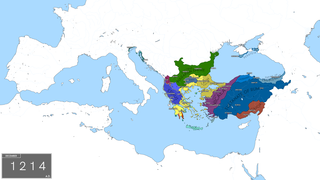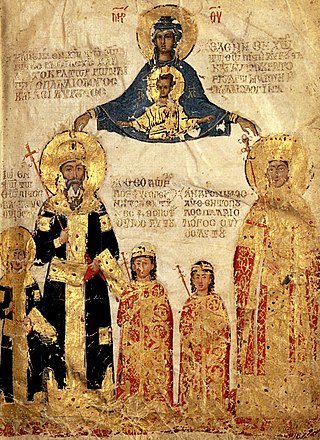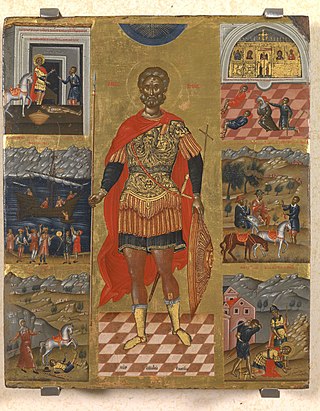Related Research Articles

Theodore I Laskaris or Lascaris was the first emperor of Nicaea—a successor state of the Byzantine Empire—from 1205 to his death. Although he was born to an obscure aristocratic family, his mother was related to the imperial Komnenos clan. He married Anna, a younger daughter of Emperor Alexios III Angelos in 1200. He received the title of despot before 1203, demonstrating his right to succeed his father-in-law on the throne.

John III Doukas Vatatzes, Latinized as Ducas Vatatzes, was Emperor of Nicaea from 1221 to 1254. He was succeeded by his son, known as Theodore II Laskaris.
George Akropolites was a Byzantine Greek historian and statesman born at Constantinople.

The Empire of Nicaea or the Nicene Empire is the conventional historiographic name for the largest of the three Byzantine Greek rump states founded by the aristocracy of the Byzantine/Roman Empire that fled after Constantinople was occupied by Western European and Venetian armed forces during the Fourth Crusade, a military event known as the Sack of Constantinople. Like other Byzantine rump states that formed after the 1204 fracturing of the empire, such as the Empire of Trebizond and the Empire of Thessalonica, it was a continuation of the eastern half of the Roman Empire that survived well into the medieval period. A fourth state, known in historiography as the Latin Empire, was established by an army of Crusaders and the Republic of Venice after the capture of Constantinople and the surrounding environs.
Marco Sanudo was the creator and first Duke of the Duchy of the Archipelago, after the Fourth Crusade.

The House of Palaiologos, also found in English-language literature as Palaeologus or Palaeologue, was a Byzantine Greek family that rose to nobility and produced the last and longest-ruling dynasty in the history of the Byzantine Empire. Their rule as Emperors and Autocrats of the Romans lasted almost two hundred years, from 1259 to the Fall of Constantinople in 1453.

Andronikos Palaiologos or Andronicus Palaeologus was a Byzantine prince and the last Byzantine governor of Thessalonica with the title of despot (despotēs), from 1408 to 1423.
The Laskaris or Lascaris family was a Byzantine Greek noble family whose members formed the ruling dynasty of the Empire of Nicaea from 1204 to 1261 and remained among the senior nobility up to the dissolution of the Byzantine Empire, whereupon many emigrated to Italy and then to Smyrna. According to George Pachymeres, they were also called Tzamantouros (Tζαμάντουρος). The feminine form of the name is Laskarina (Λασκαρίνα).
Manuel Komnenos Maurozomes was a Byzantine nobleman who in the aftermath of the Fourth Crusade tried to found an independent principality in Phrygia. His daughter, named Dawlat Raziya Khatun, was married to the Seljuk sultan Kaykhusraw I, and he eventually became governor (emir) of part of the region under Seljuk control; he was an influential figure in the Seljuk court until his death.
Alexios Komnenos Strategopoulos was a Byzantine aristocrat and general who rose to the rank of megas domestikos and Caesar. Distantly related to the Komnenian dynasty, he appears in the sources already at an advanced age in the early 1250s, leading armies for the Empire of Nicaea against Epirus. After falling out of favour and being imprisoned by Theodore II Laskaris, Strategopoulos sided with the aristocrats around Michael VIII Palaiologos, and supported him in his rise to the throne after Theodore II's death in 1258. He participated in the Pelagonia campaign in 1259, going on to capture Epirus, but his successes were undone in the next year and he was captured by the Epirotes. Released after a few months, he led the unexpected reconquest of Constantinople from the Latin Empire in July 1261, restoring the Byzantine Empire. He was captured again by the Epirotes in the next year and spent several years in captivity in Italy, before being released. He retired from public affairs and died in the early 1270s.

Cretan School describes an important school of icon painting, under the umbrella of post-Byzantine art, which flourished while Crete was under Venetian rule during the late Middle Ages, reaching its climax after the Fall of Constantinople, becoming the central force in Greek painting during the 15th, 16th and 17th centuries. The Cretan artists developed a particular style of painting under the influence of both Eastern and Western artistic traditions and movements; the most famous product of the school, El Greco, was the most successful of the many artists who tried to build a career in Western Europe, and also the one who left the Byzantine style farthest behind him in his later career.

The Nicaean–Venetian Treaty of 1219 was a trade and non-aggression defense pact signed between the Empire of Nicaea and the Republic of Venice, in the form of an imperial chrysobull issued by Emperor Theodore I Laskaris. This treaty provided the Venetians freedom of trade and imports without customs duties throughout the Empire, in exchange for not supporting for the newly created Latin Empire.
Manuel Doukas Chrysaphes was the most prominent Byzantine musician of the 15th century.
Angelos Akotantos was a Greek painter, educator, and protopsaltis. He painted in the Byzantine style or maniera greca. He represented the transition from the Byzantine style of painting to the more refined Cretan School. Angelos's students were Andreas Pavias, Andreas Ritzos, and Antonios Papadopoulos. He influenced the future artists of the Cretan School, namely Georgios Klontzas, Theophanes the Cretan, Michael Damaskinos and El Greco. Angelos's brother Ioannis Akotantos was also a famous painter. There are 50 paintings all over the world by Akotantos. Thirty are signed and twenty have been reliably attributed to the artist.

The island of Crete came under the rule of the Byzantine Empire in two periods: the first extends from the late antique period to the conquest of the island by Andalusian exiles in the late 820s, and the second from the island's reconquest in 961 to its capture by the competing forces of Genoa and Venice in 1205.
John Kladas was a Byzantine composer. He had the post of lampadarius in the cathedral of Hagia Sophia of Constantinople. He wrote several works on the theory of music, the most important being the Grammatike tes mousikes.

Theodore II Eirenikos, , also known as Theodore Kopas or Koupas (Κωπάς/Κουπάς), was a high-ranking Byzantine official and chief minister during most of the reign of the Byzantine emperor Alexios III Angelos. After the fall of Constantinople to the Fourth Crusade, he fled to the Empire of Nicaea, where he became a monk and served as Patriarch of Constantinople in exile in 1214–1216.
Peter the Byzantine, also known as Petros Byzantios, and "the Fugitive", was a Greek composer and scribe. A pupil of Peter the Peloponnesian, he served the Ecumenical Patriarchate of Constantinople as Domestikos, Lambadarios (1789–1800), and Arch-cantor (1800–1805).
Niccolò Sagundino was a Greek-born Venetian secretary, diplomat and humanist. He wrote numerous letters, as well as religious and philosophical treatises, mostly in Latin.
References
- 1 2 3 4 5 6 7 Achilleas Chaldæakes, "A New Reading of John Laskaris's Explanation and Modulation of the Musical Art: Towards a Critical Edition of Laskaris's Theoretical Treatise," in Vesna Sara Peno and Ivan Moody (eds.), Aspects of Christian Culture in Byzantium and Eastern Christianity: Word, Sound and Image in the Context of Liturgical and Christian Symbolism (Belgrade, 2017): 55–84.
- 1 2 3 Dimitri E. Conomos (1991). "Laskaris, John". In Kazhdan, Alexander (ed.). The Oxford Dictionary of Byzantium . Oxford and New York: Oxford University Press. ISBN 0-19-504652-8.
